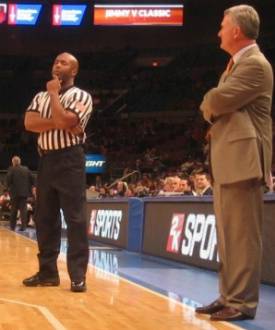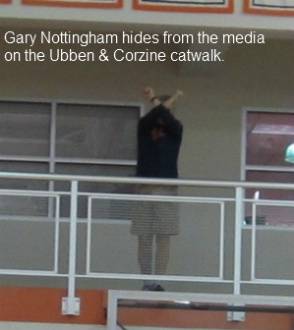Bruce Weber’s bizarre exodus — part tear-wrenching press conference, part ice cream social — perfectly summarized the Weber Saga at Illinois: inscrutable. It’s not what you expect. It’s hard to understand. And yet it unfolds right before your eyes, for all to see.
 But people see things differently. Given the same evidence, people come to different conclusions.
But people see things differently. Given the same evidence, people come to different conclusions.
In the immediate aftermath of Weber’s termination, he and his supporters instigated a campaign against Mike Thomas. Or they didn’t. It depends on whom you ask.
Whether a coordinated campaign, or a series of unrelated events, Weber’s friends — coaches Tom Izzo, Kevin Stallings, Gene Keady and Matt Painter, and various sports writers — trumpeted the notion that Thomas, the first year Illini Director of Athletics, had done Weber wrong.
These people seemed to read from the same script of talking points: Weber had the best nine year run in Illini basketball history. Thomas never had a one-on-one meeting with Weber. Thomas undermined the team by not offering Weber a “vote of confidence” during a February 11 radio interview. Weber is one of the best five coaches in all of college basketball. Weber is an honest man and “does things the right way.”
Everyone involved stood to gain by participating in Weber’s PR war. Coaches battling Illinois for recruits, or in Big Ten Conference games, may gain a competitive advantage by admonishing the Illini publicly. The sports writers get attention, which translates to page views and advertising revenue.
The only person in the Weber Camp risking blowback from this anti-Illinois campaign is Weber himself. Longtime Illini and Weber supporters voiced annoyance. The “Bruce Weber is a great guy” meme saw disavowal among many of its adherents. But that’s a subjective analysis, impossible to quantify. There’s a more important question. Did Weber violate any agreement with the University of Illinois? If so, does such a violation void the university’s obligation to pay Weber’s $4,062,023.79 buyout?
I will address this question tomorrow.
Another meme about Bruce Weber that could be analyzed and, to some degree, quantified: is Bruce Weber as “clean” as his reputation?
Through Freedom of Information Act inquiries, I sought documentation of self-reports regarding NCAA compliance, and secondary violations. For comparison, I made the same inquiry to two other Illinois public universities with Division I basketball programs and to four other Big Ten universities.
In Bruce Weber’s tenure (April 30, 2003 through March 9, 2012) Illini basketball reported Level I and Level II infractions on 28 separate occasions. Twenty-six of those violations were attributed to Weber’s administration, while the other two were remnants from the final days of the Bill Self era.
This slideshow features a list of these violations. The list includes a 29th violation reported in April 2003, prior to Weber’s hiring.
In that same period, Wisconsin tallied the second highest number with 15 violations. The University of Minnesota tallied 14, as did Southern Illinois University at Carbondale. Michigan State University reported 11. The University of Iowa and Illinois State University reported ten (or possibly twelve for ISU, which also reported two variations, or extrapolations, on two of their self-reports.)
Ohio State (Jim O’Brien) and Indiana University (Kelvin Sampson) committed major violations during this period.
RECRUITING VIOLATIONS
The Weber-era featured common recruiting faux pas: excessive contact with a particular recruit (excessive in that the number of times a staff may contact a recruit is finite and defined), impermissible freebies to persons in positions of influence, touting particular recruits in social media, touting prospective recruits to traditional media, and providing free transportation.
Also, Illinois reported multiple cases of phone calls and texts to recruits that exceeded numerical limits during a specific time frame, or occurred when no contact was allowed (the official NCAA Recruiting Calendar). As Indiana Hoosiers fans might say, “it’s just phone calls.”
NON-COACHING STAFF INVOLVED IN COACHING
Another common Weber infraction was “Too Many Coaches.” The NCAA limits member institutions to four full-time coaches on staff. That’s for parity purposes. Schools like Kentucky and Duke can afford 30 assistants. Schools like Savannah State can barely pay anybody. If schools could employ any number of people to perform coaching duties, titular assistant coaches could spend 100 percent of their time on the recruiting trail. If there were no limit on recruiting personnel, you’d never get a seat at a Simeon game.
 Illinois violated the coach cap in practices and games, probably many more times than reported, and most likely without knowing it. Defining “coaching activities” is murky territory. What if you tell a guy to tie his shoelaces? Is that coaching?
Illinois violated the coach cap in practices and games, probably many more times than reported, and most likely without knowing it. Defining “coaching activities” is murky territory. What if you tell a guy to tie his shoelaces? Is that coaching?
For one infraction, former Illini Assistant to the Head Coach Gary Nottingham was officially reprimanded and docked a day’s pay. Nottingham had been a head coach before coming to Illinois for 18 years. One can only imagine how hard it is to not correct a simple mistake or even comment on it. But Nottingham learned the hard way. That’s probably why every story he shared, no matter how amusing and innocuous, always ended with the same admonition: “Please don’t write that.”
Chester Frazier, now learning the coaching profession in Kansas, probably cringed when he saw this message board post.

The number of instances can be defined only by the number of official reports, and during Weber’s tenure, only three official violations were tallied.
IMPERMISSIBLE EXCHANGES OF MONEY
If message boards can create heated arguments on the basis of Mike Thomas’s inert February 11 comments, these relatively minor infractions should produce volcanic outbursts. “Payments to players,” the phrase alone seems inflammatory.
These payments involve no briefcases full of cash. They are not the seamy species that brought notoriety to John Wooden’s championship UCLA teams. They aren’t the kinds of payments that got Jim O’Brien and Steve Fisher fired from Big Ten Schools. They’re the kind that got Harry Combes fired from Illinois.
Combes was Illini Men’s Basketball Coach from 1947–67. His “Slush Fund” doled out “walking-around money” to players, permissible by NCAA Rules in 1966. Small cash payments are still permissible today, in specific amounts and circumstances. Ostensibly, cash is distributed to players for the sole purpose of buying meals while traveling. The difference for Harry Combes, football coach Pete Elliott, and indignant Illinois athletic department whistle-blower Mel Brewer is that “walking-around money” was not permitted by the Big Ten in 1966.
Illinois’ compliance office reported excessive or impermissible payments on three occasions. The actual number of payments is not as easy to quantify, because one report covers the entire 2005 NCAA Tournament run, a period of more than three weeks’ duration. The amounts of these payments is not specified within the annotated list of violations submitted by the University of Illinois. The university sought my explicit agreement to receive results in list form rather than complete, compiled reports.
The Universities of Wisconsin and Iowa chose to submit complete documents, rather than lists. Wisconsin was the only other school to report excessive or impermissible payments. Like Illinois, Wisconsin disbursed money on numerous occasions, once for a meal that had already been provided.
How frequently are impermissible payments reported? No publicly available data exists.
Cameron Schuh, an NCAA spokesman, answered my question on this point: “Aside from the information found on this public database, we do not release what information schools report that do not reach the level of major infractions.”
OTHER SCHOOLS
Complete responses from all schools will publish in the final installment in this series. Since Wisconsin and Iowa chose to submit complete reports rather than lists of documented violations, they were the only two schools disclosing names and details. Wisconsin’s reports include some dirty laundry from the Dick Bennett years. A 2004 expense request finds the “spouse” of a student athlete seeking remuneration for travel expenses for the 2004 NCAA Tournament. She claims to have received expenses for the 2000 Final Four. (Go ahead and do the math. Which fifth year senior was married as a freshman in 2000?)
Of the schools queried, perhaps the most exciting recruiting violation came from Iowa. Here’s a slideshow displaying the documentation of Iowa’s impermissible enticement of Josh Oglesby and Marcus Paige by Ashton Kutcher and Demi Moore.
Especially interesting are the handwritten memoranda which, while redacted, ostensibly derived from the two teenagers. Intriguingly, both notes are dated “11-17-2010” and appear to have been written on the kind of Mead binder paper that kids like me would have used in the twentieth century.
Paige chose to play for the North Carolina Tarheels. Oglesby is now a Hawkeye.
VOTE OF CONFIDENCE
Can Illini Basketball’s 2012 collapse be attributed to new athletic director Mike Thomas? Well, the Illini staff committed six (documented) violations in each of the seasons prior to Thomas’s arrival and only one during the year Thomas oversaw the program. So maybe it really was his fault. Or maybe, as those Indiana fans liked to say, Weber stopped trying.








